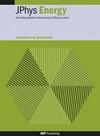Performance evaluation of a novel synchronously interdigitated/winded lithium-ion battery configuration enabled by 3D printing through numerical simulations
IF 6.3
3区 材料科学
Q1 ENERGY & FUELS
引用次数: 0
Abstract
Thick electrodes with higher energy density are highly desirable for lithium-ion batteries (LIBs). However, the sluggish transport of Li-ions in thick electrodes is a critical challenge. In this study, a novel synchronously interdigitated/winded battery configuration enabled by 3D printing is proposed. The cathode, separator, and anode are synchronously interdigitated in the core and synchronously winded in the outer-rings to form an integrated full battery. With this novel battery configuration, Li-ions can transport between neighboring cathode and anode, thereby significantly reduce the transport distance of Li-ions, and improve the electrochemical reaction kinetics. To evaluate the electrochemical performance of this battery configuration, this study investigates the effects of various parameters including the electronic conductivity, electrode porosity, electrode line width, separator thickness, and number of winded outer-rings on the electrochemical performance through numerical simulations. Results showed that electronic conductivity is the most crucial factor in determining the electrochemical performance. In combination with multi-material 3D printing, the battery configuration proposed in this study may be utilized to build LIBs with higher energy density.通过数值模拟对3D打印实现的新型同步叉指/卷绕锂离子电池配置的性能评估
具有较高能量密度的厚电极对于锂离子电池(LIBs)是非常需要的。然而,锂离子在厚电极中缓慢的传输是一个关键的挑战。在这项研究中,提出了一种通过3D打印实现的新型同步叉指/卷绕电池配置。阴极、隔板和阳极在芯中同步叉指,并在外圈中同步缠绕,形成一体的全电池。利用这种新型电池配置,锂离子可以在相邻的阴极和阳极之间传输,从而显著缩短锂离子的传输距离,改善电化学反应动力学。为了评估这种电池配置的电化学性能,本研究通过数值模拟研究了各种参数对电化学性能的影响,包括电子电导率、电极孔隙率、电极线宽、隔膜厚度和缠绕外圈的数量。结果表明,电子电导率是决定电化学性能的最关键因素。结合多材料3D打印,本研究中提出的电池配置可用于构建具有更高能量密度的LIBs。
本文章由计算机程序翻译,如有差异,请以英文原文为准。
求助全文
约1分钟内获得全文
求助全文
来源期刊

Journal of Physics-Energy
Multiple-
CiteScore
10.90
自引率
1.40%
发文量
58
期刊介绍:
The Journal of Physics-Energy is an interdisciplinary and fully open-access publication dedicated to setting the agenda for the identification and dissemination of the most exciting and significant advancements in all realms of energy-related research. Committed to the principles of open science, JPhys Energy is designed to maximize the exchange of knowledge between both established and emerging communities, thereby fostering a collaborative and inclusive environment for the advancement of energy research.
 求助内容:
求助内容: 应助结果提醒方式:
应助结果提醒方式:


